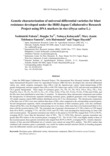Genetic characterization of universal differential varieties for blast resistance developed under the IRRI-Japan Collaborative Research Project using DNA markers in rice (Oryza sativa L.)
JIRCAS Working Report
| ISSN | 1341710X |
|---|---|
| 書誌レコードID(総合目録DB) | AA11159468 |

本文フルテキスト
Under the IRRI-Japan Collaborative Research Project, The International Rice Research Institute (IRRI) and the Japan International Research Center for Agricultural Sciences (JIRCAS) have developed four universal differential variety sets, which comprise monogenic lines (MLs) with the Japonica-type variety Lijian-xintuan-heigu (LTH) genetic background, and near isogenic lines (NILs) with LTH, Indica-type variety CO39, and universal susceptible line US-2 genetic backgrounds. These target 24 resistance genes: Pia, Pib, Pii, Pik, Pik-h, Pik-m, Pik-p, Pik-s, Pish, Pita(Pi4), Pita-2, Pit, Piz, Piz-5(Pi-2), Piz-t, Pi1, Pi3(t), Pi5(t), Pi7(t), Pi9, Pi11(t), Pi12(t), Pi19(t) and Pi20(t), and the MLs have been distributed to more than 15 countries. To characterize these chromosome components and confirm the introgression of chromosome segments harboring resistance genes, graphical genotypes were investigated using 162 simple sequence repeat (SSR) markers distributed across all 12 rice chromosomes. The chromosome components of the three sets of NILs were more uniform than those of MLs when compared to the corresponding recurrent parent. Several introgression segments, which corresponded to the locations of blast resistance genes, were also confirmed. Almost all the MLs were developed by backcrossing one or two times, while some lines were backcrossed three to five times with the recurrent parent, LTH. The restoration rate of genomic chromosomes of 31 MLs relative to LTH ranged from 50 to 90.0%, averaging 77.3%. All LTH, CO39, and US-2 NILs were developed by backcrossing six times with each recurrent parent. The genome restoration rate relative to the parent in 34 LTH NILs ranged from 75.6% to 96.9%, averaging 90.6%; lower than the theoretical value of 99%. The 31 CO39 NILs showed a genome restoration rate greater than 90% relative to the recurrent parent, averaging 97.3%. The 16 US-2 NILs were highly similar to those of the recurrent parent: these genome restoration rates ranged from 88.9% to 98.8%, averaging 94.6%. Genetic characterizations of four universal differential sets of varieties were carried out using DNA markers. This DNA marker data combined with resistance genes is potentially very useful for marker-assisted selection (MAS) in breeding programs since the differential varieties can be applied as gene sources.
| 刊行年月日 | |
|---|---|
| 作成者 | Yoshimichi Fukuta Donghe Xu Nobuya Kobayashi Mary Jeanie Telebanco-Yanoria Aris Hairmansis Nagao Hayashi |
| 著者キーワード | Resistance gene differential variety chromosome component Blast (Pyricularia oryzae Cavara.) rice (Oryza sativa L.) |
| 巻 | 63 |
| 開始ページ | 35 |
| 終了ページ | 68 |
| 関連するリソース | 部分である : JIRCAS Working Report no.63 |
| 言語 | eng |
関連する刊行物
部分である
